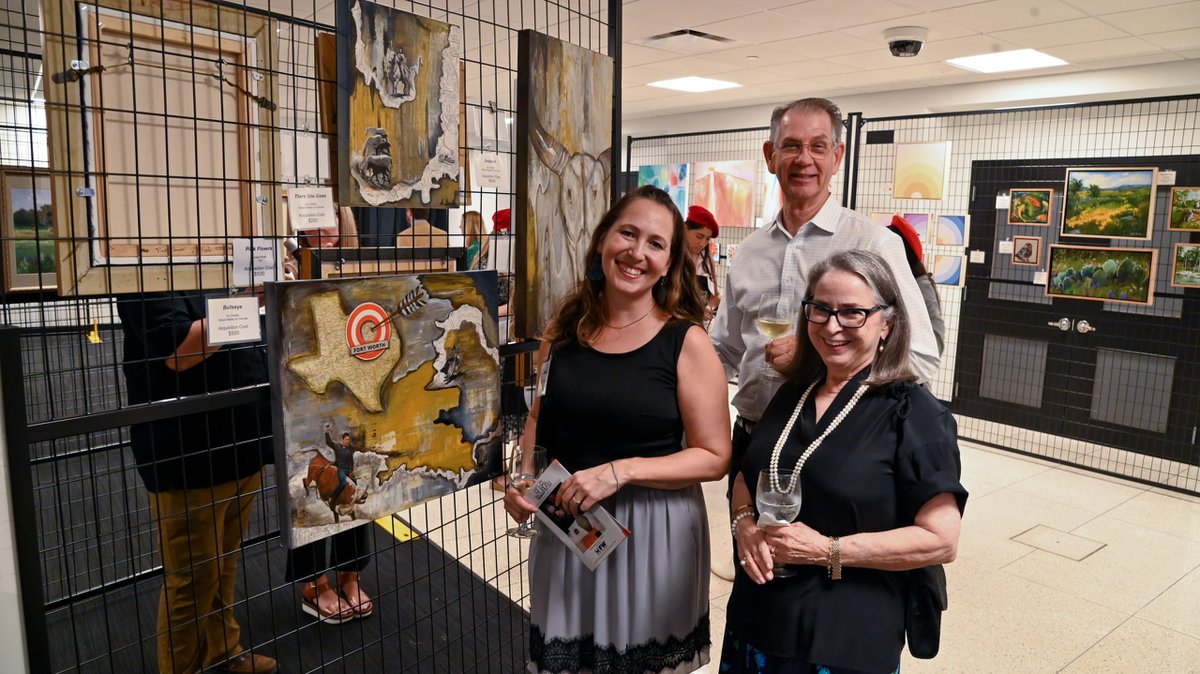Long before the first painting is hung or the first glass of wine is poured, the crew at Historic Fort Worth, Inc. is busy doing what they’ve always done best — making something out of nothing.
Each September, in the basement of a downtown office tower, they transform concrete floors and construction fencing into one of the city’s most distinctive art shows. “Preservation is the Art of the City” began as a scrappy fundraiser. Still, it has grown into a crucial lifeline for both artists and the 501(c) (3), keeping the city’s historic preservation alive.
“We knew about the Fort Worth Circle Artists — a group that fueled an art movement here — and thought, what if we keyed off that?” says Jerre Tracy, executive director of Historic Fort Worth, Inc. “It became more than just keeping the lights on. It became about building community.”
Held September 4–6 in the lower level of the First on 7th building at 500 W Seventh St. — once the home of the First National Bank — the 2025 edition features paintings, photography, sculpture, and mixed media by a curated mix of returning and first-time artists. The work hangs on freestanding panels of Modu-Loc fencing — the kind you’d expect at a construction site — lending the space an improvised, industrial energy that mirrors the show’s scrappy origins.
After the closure of the Fort Worth Community Arts Center, Tracy and her team found themselves without a venue and few viable options. Then one morning over coffee at Buon Giorno, someone spotted a solution across the street. “We looked out and saw the construction fencing,” Tracy says. “It looked like something we could hang art on. That’s how we became portable.”
That portability, it turns out, is part of the magic. Over the years, “Preservation is the Art of the City” has been mounted everywhere from the Fort Worth Central Library to the Fort Worth Woman’s Club. What’s stayed consistent is the show’s mission: to support artists and historic preservation in equal measure.
Each year, a jury selects eight to twelve new artists from a call that goes out to more than 6,000 subscribers. They’re folded into a lineup of returning exhibitors, with every piece of art priced and hung by hand. The show operates on a model that ensures sustainability for both sides: artists keep 65 percent of every sale, while Historic Fort Worth receives the other 35 to fund its operations and advocacy.
That structure means artists don’t have to undersell their work to participate. “It has made the art show relevant to artists and the art show relevant to Historic Fort Worth,” Tracy says.
This year’s featured artist is Carolyn Natishyn, a Dallas native whose classical training in piano, music theory, and art history informs her richly textured paintings. Honorees Mary Kathryn Anderson and Warren Gould will be recognized for their longtime support of the arts and local preservation.
Though the event now includes cameras and hired security, the spirit of accessibility remains. Friday and Saturday admission is free to the public, and the space encourages a casual kind of intimacy — visitors stop to chat with artists, swap stories, and occasionally walk out with something they didn’t know they needed until they saw it hanging under fluorescent lights.
And for all its challenges, “Preservation is the Art of the City” continues to prove that creativity and cultural stewardship aren’t separate things in Fort Worth. They’re two sides of the same canvas.
“It has made the art show relevant to artists and the art show relevant to Historic Fort Worth,” Tracy says.
